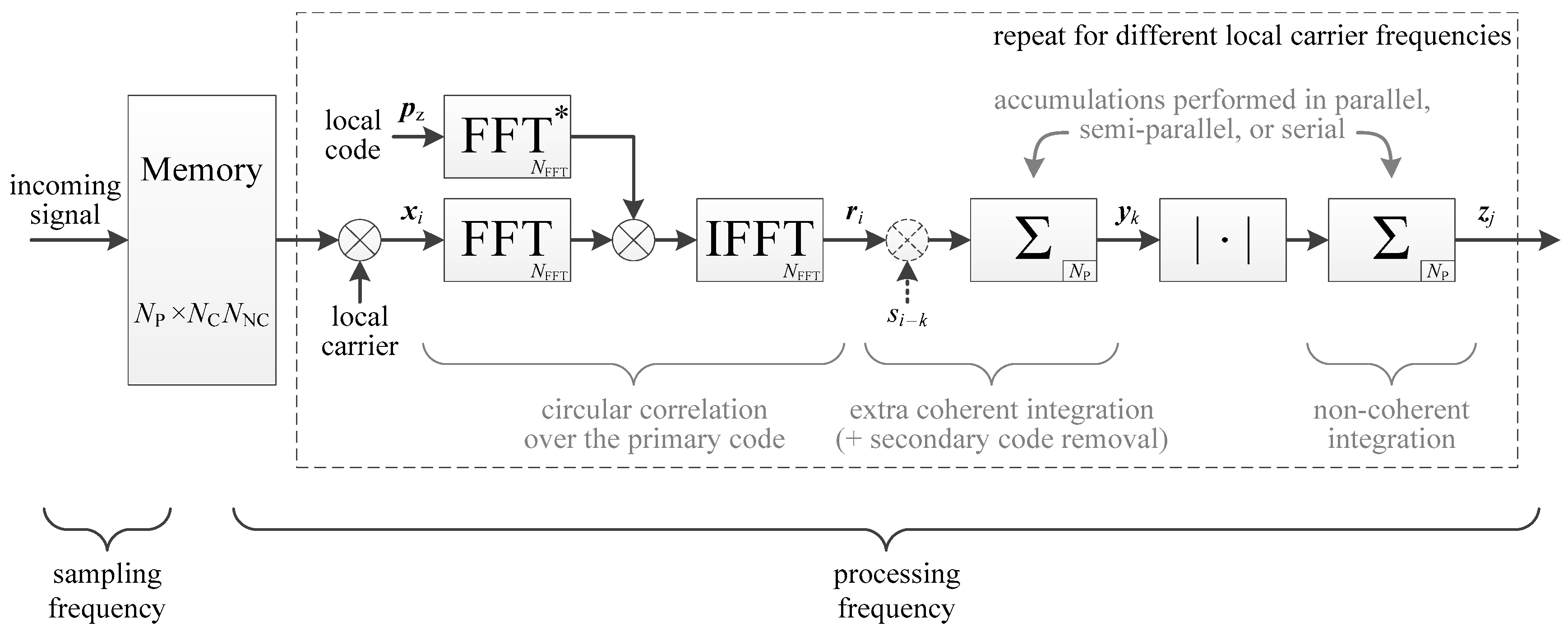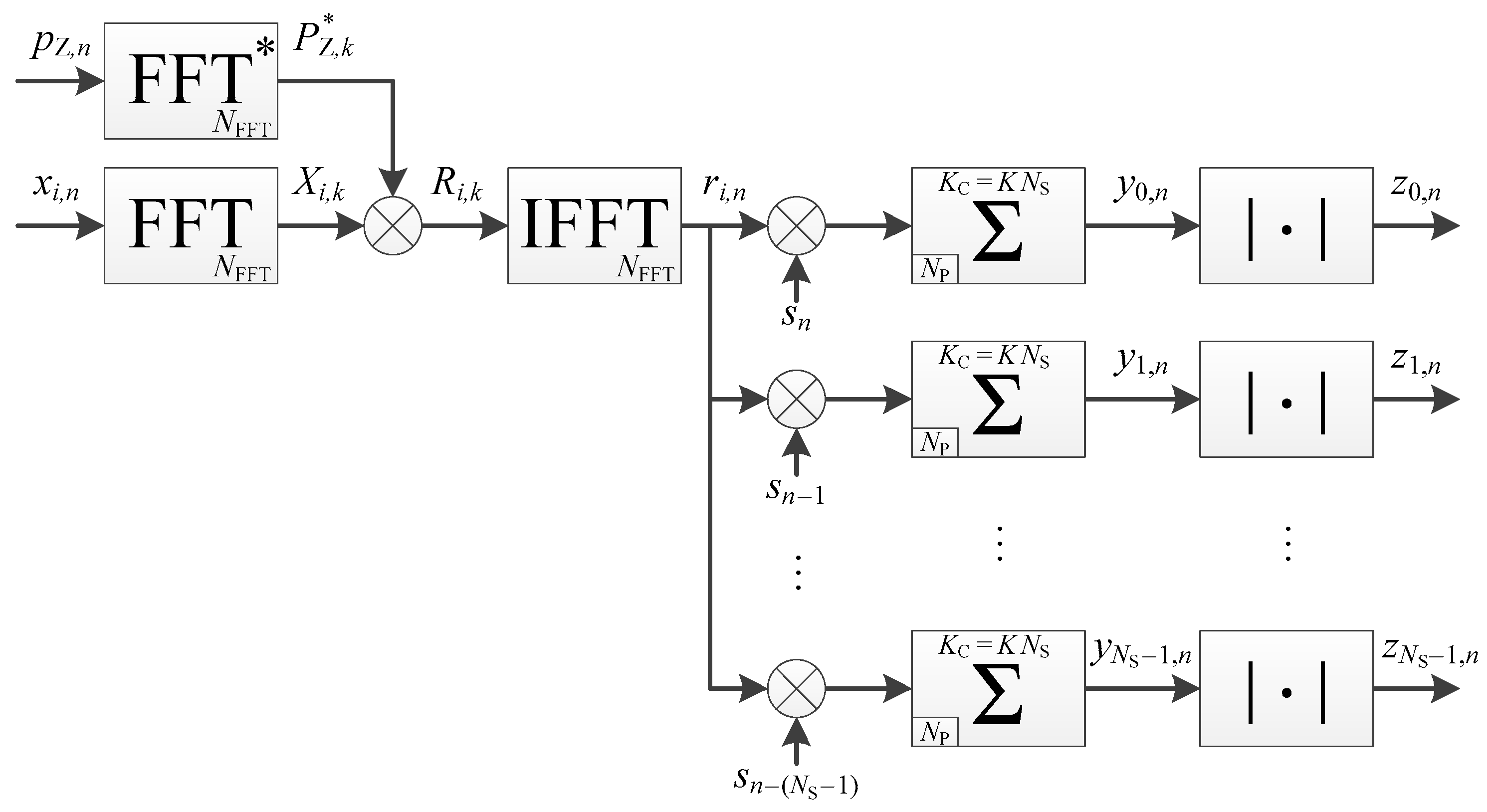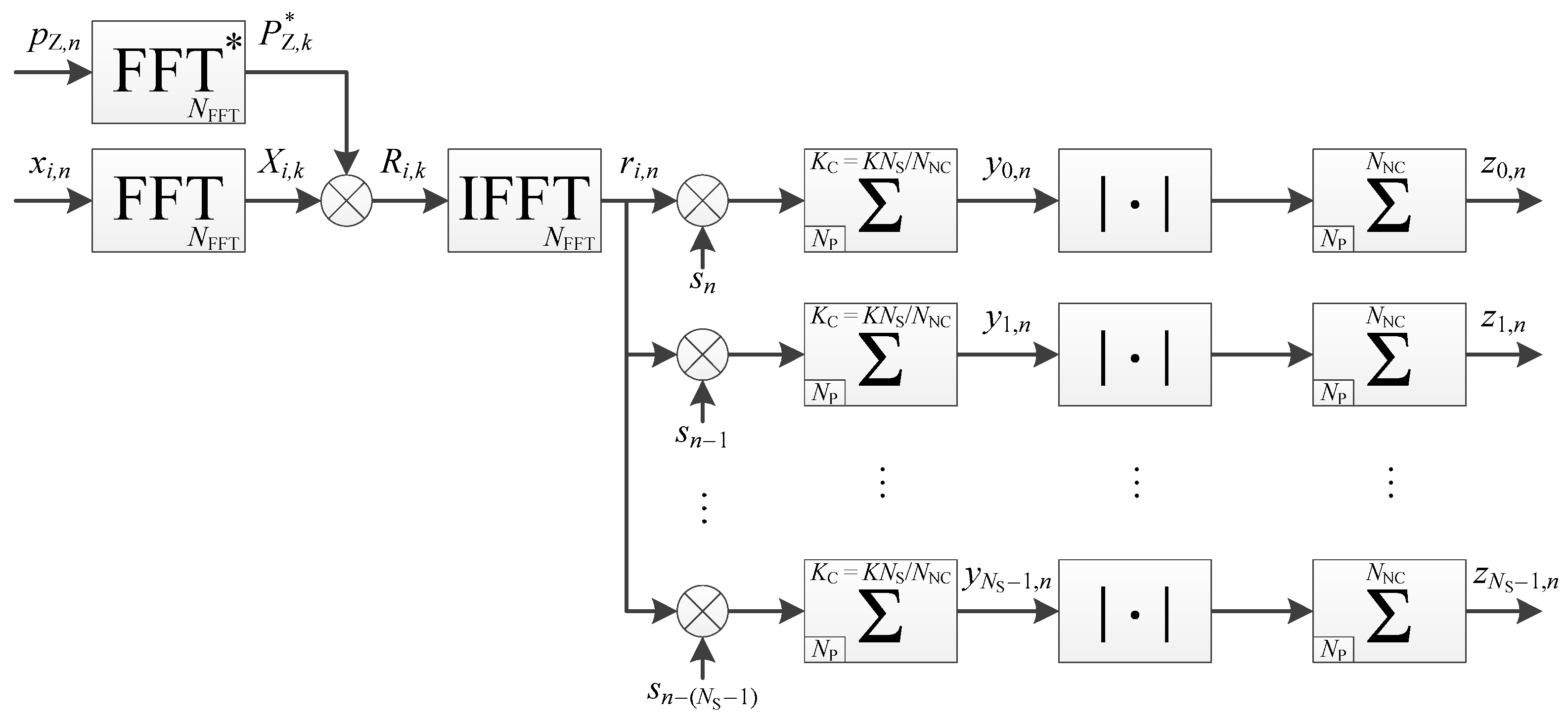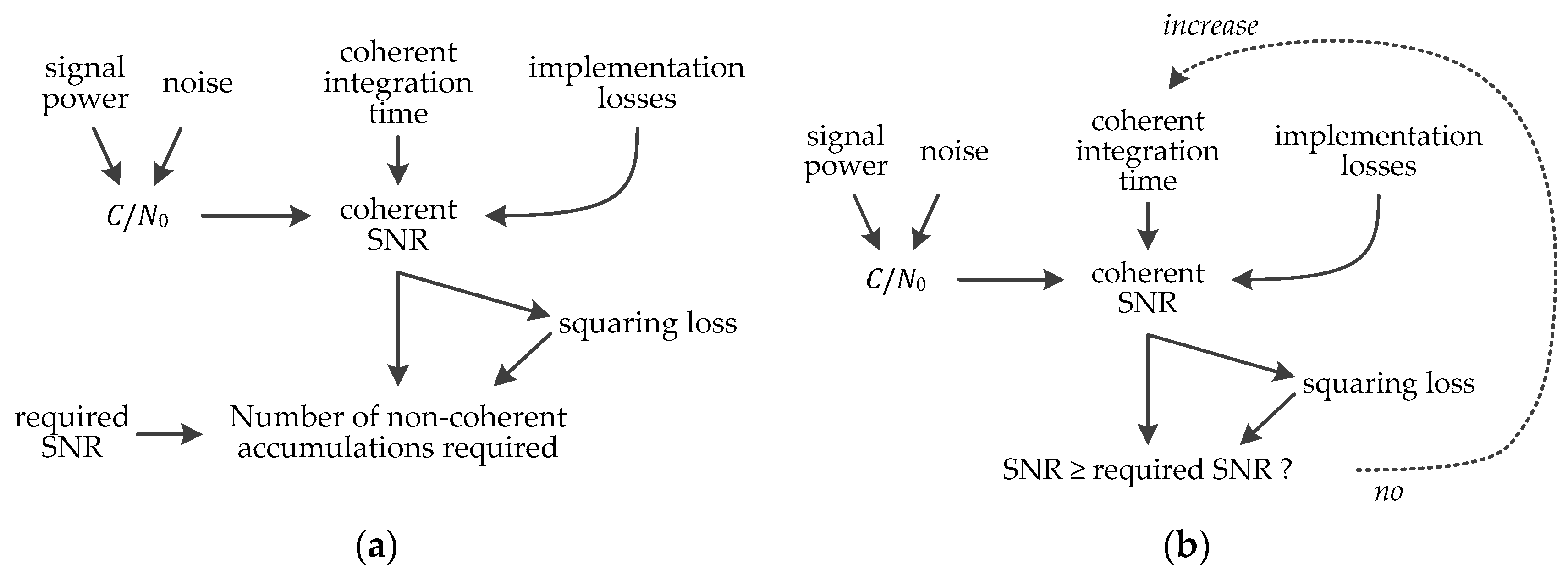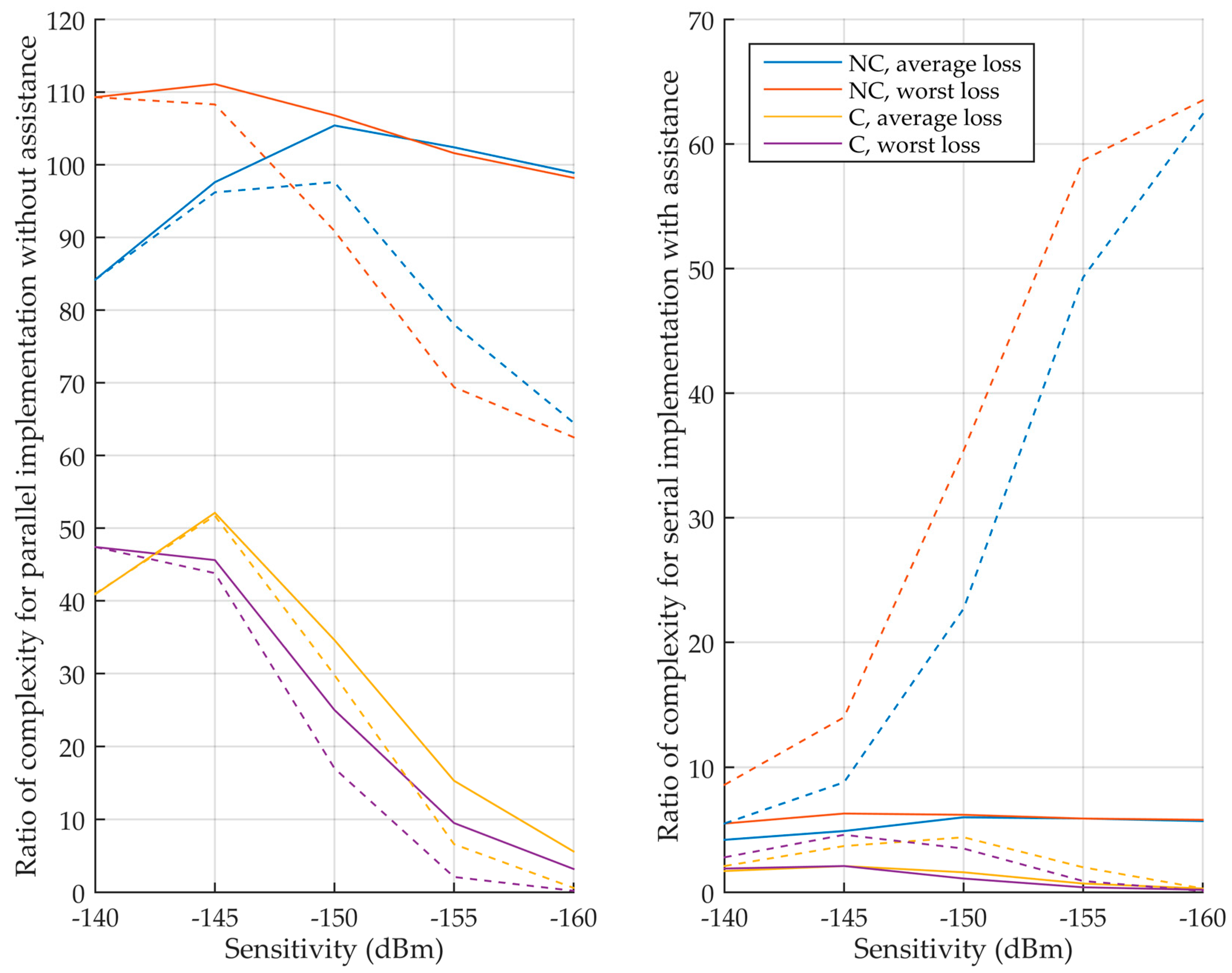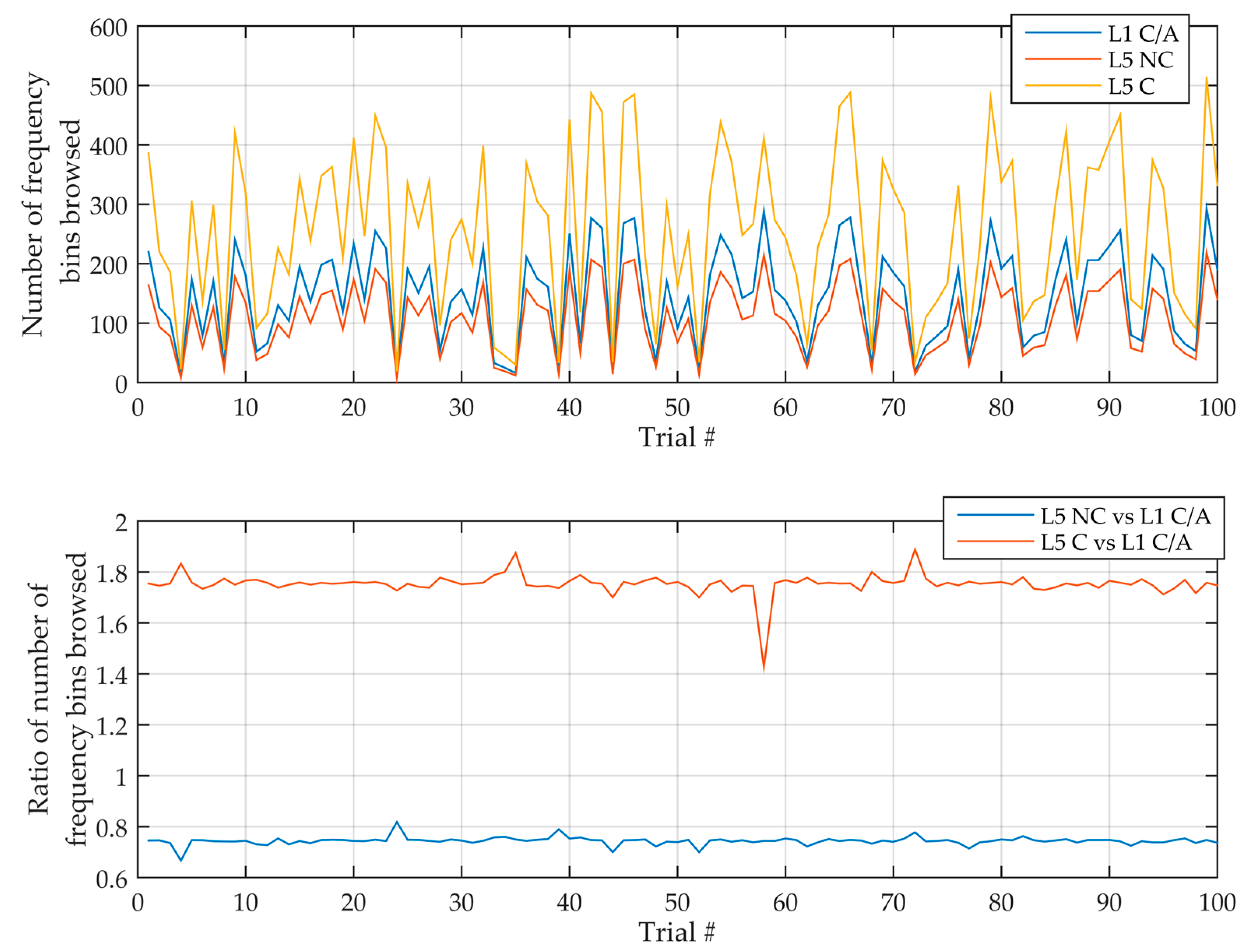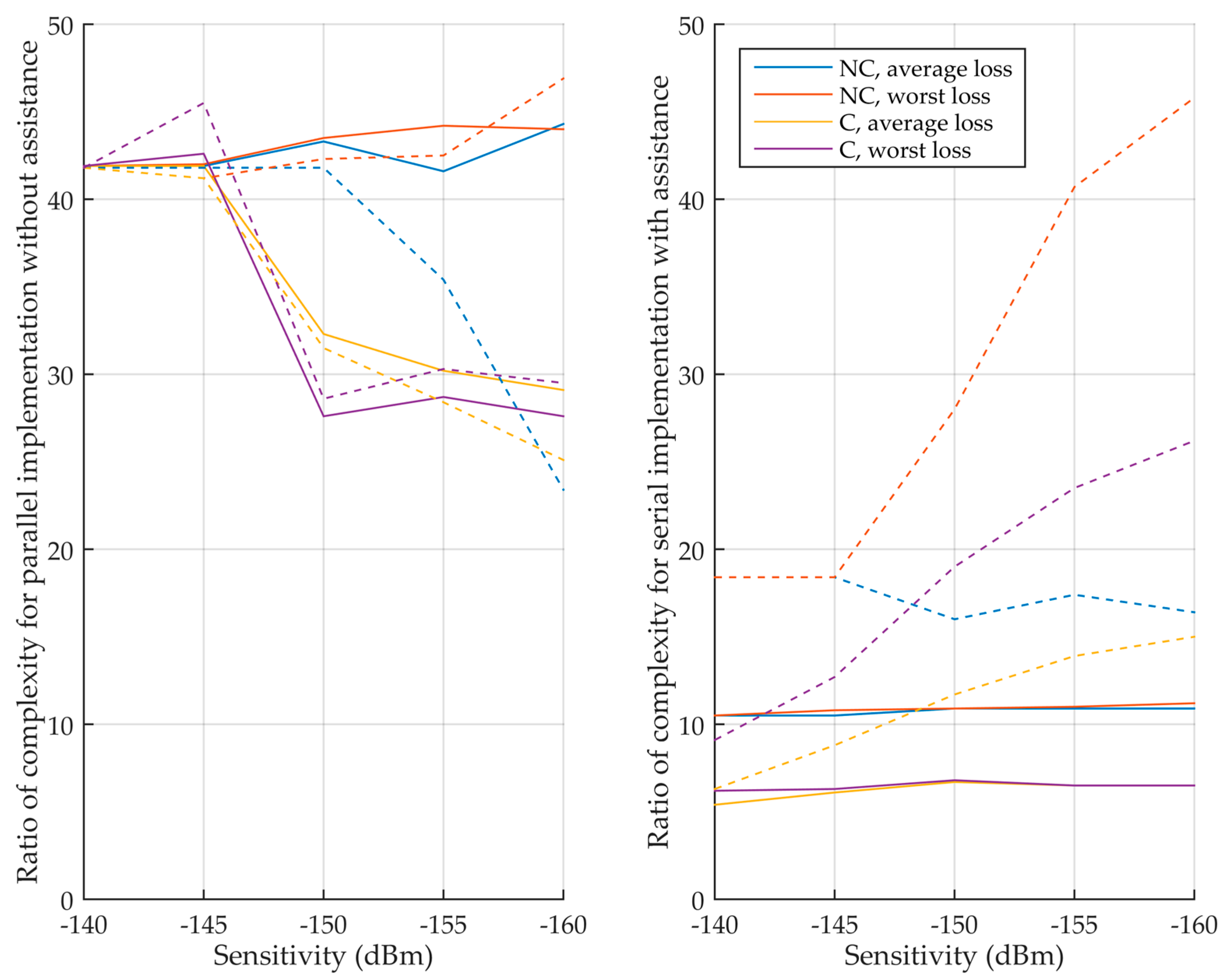4.1. Determination of the Integration Time
Now, let us compare the different implementations with actual parameters. To have a good overview of the performance, several sensitivities are selected, from −140 dBm to −160 dBm with a step of 5 dBm to cover moderate to high sensitivities. However, as mentioned in the introduction and shown in
Table 1, the expected power is not the same for the different signals. Therefore, to perform a fair comparison, the sensitivities should be adapted for each signal, and the values above would be for one signal only. Here the GPS L1 C/A has been chosen as reference. Since the GPS L5 signal has an expected power 1.5 dB above the L1 C/A signal power, the sensitivities considered for the L5 signal are −138.5 dBm, −143.5 dBm, −148.5 dBm, −153.5 dBm, and −158.5 dBm. This allows us to do a fair comparison representative of the reality. The same will apply for the Galileo signals.
Then, again to have a fair comparison, some elements must be considered specifically for each signal: The number of frequency bins and code bins, which influence the size of the search space and consequently influence the required Signal-to-Noise Ratio (SNR), probability of false alarm and probability of detection. This is illustrated in
Figure 10, with
the number of frequency bins,
the number of primary code bins,
the number of secondary code bins,
the number of code bins,
the number of cells of the search space,
and
the global and cell probabilities of false alarm respectively, related by
or
, and
the probability of detection [
8].
Finally, once the required SNR is estimated, the coherent integration time and the number of non-coherent accumulations can be evaluated, as shown in
Figure 11. The implementation losses depend on the quantization, frequency step, code step, and potential sign transition. Following the outcomes of [
32], a 3-bit quantization, a frequency step
of
, and a code step of 1/2 chip is considered, and since the full bit method and secondary code correlation is used there is no transition loss. Regarding the case of coherent integration only,
Figure 11b shows that this is an iterative process. There is even a second iteration not shown in
Figure 10 and
Figure 11, because increasing the coherent integration will decrease the frequency step (since
). This will increase the number of frequency bins
(since
with
the search space), which itself increases the required SNR after
Figure 10, which consequently may change the coherent integration time after
Figure 11b. Therefore, for a very accurate estimation in the case of coherent integration only, these iterations should be performed.
4.2. Comparison of GPS L1 C/A and L5 Signals Acquisition
4.2.1. Determination of Acquisition Parameters
The general parameters independent of the integration time that have been selected are summarized in
Table 3 (the spreadsheets used to obtain the further tables are available in
supplementary materials). The sampling frequencies are chosen to be as low as possible, because it is desired that the acquisition be as fast as possible, i.e., slightly above twice the chipping rate since these are BPSK signals (it is not exactly twice the chipping rate because the sampling frequency should never be a multiple of the chipping rate, else it would lead to a very bad accuracy in the estimation of the pseudo-ranges and position [
33]).
Starting with the L1 C/A signal, a typical search space of ±5 kHz is considered [
8], and since the coherent integration time is fixed to 20 ms, the frequency step is
33.3 Hz, implying 2 × 5000/33.3 ≈ 300 frequency bins. The code step is one sample, giving 2048 code bins. The number of cells is thus 300 × 2048 = 614,400. A global probability of false alarm of
is chosen to avoid false alarms, which gives
, and finally a typical probability of detection of 0.9 is chosen following [
8], which gives a required final SNR of 17.15 dB.
Since a case of assistance will be considered for the L5 signal, this same assistance should be considered for the L1 C/A signal to make a fair comparison. As mentioned previously, the assistance indicates the current chip of the secondary code (or a small range), and the information needed for this information (time, and receiver and satellites position) can also be used to reduce the frequency search space. Therefore, with assistance, counting an error of 60 Hz due to almanac inaccuracy and an uncertainty of 180 Hz for the receiver velocity (Doppler added by a receiver at 130 km/h in the direction of a satellite) [
8], it will be assumed that the search space is reduced to 16 bins, corresponding to ±266.7 Hz.
The same is done for the L5 signal, considering four cases, coherent integration limited to 20 ms or unlimited, and with or without assistance. One difference in the assumptions is that since the L5 frequency is about 75% the one of the L1 frequency, the expected Doppler and the search space for an L5 signal should be reduced. This gives 225 frequency bins without assistance (±3750 Hz), and 12 frequency bins with assistance (±200 Hz). For the L5 signal, the assistance reduces the number of secondary code bin and consequently the number of code bins . For the application here, the best assistance is assumed, i.e., the current secondary code chip is known and and .
Table 4 summarizes all this information. Note that to be very accurate, the number of frequency bins for the unlimited
case should be higher since
, and an iterative calculation should be performed as mentioned previously. However, this would lead to a different required SNR for each sensitivity, which would be hard to synthesize. Consequently, the same number of frequency bins is considered as simplification, keeping in mind that for these two cases the performance will be a little bit optimistic compared to the real one. Note also that another approximation is made, namely that a Gaussian variable is considered for the detection test. This is the case when the number of non-coherent accumulations is high, however, when there is not or a just few non-coherent accumulations, the variable is not Gaussian, which would affect the way the probabilities of false alarm and detection are calculated [
8].
Now that the required SNR is determined, the coherent and total integration times can be estimated following
Figure 11, and the values are summarized in
Table 5 and
Table 6, considering the average and worst case regarding the implementation losses (quantization, frequency step, and code step), namely 0.55 + 0.53 + 1.16 = 2.24 dB and 0.55 + 1.65 + 2.50 = 4.70 dB respectively.
Before going on the evaluation of the different implementations,
Table 7 shows the ratio of the total integration time between several cases to quantify the impact of using the L5 signal, unlimited coherent integration time, and assistance. From
Table 7, it is clear that the main way to reduce the total integration time is to increase the coherent integration time, especially for very weak signals. Then, the use of L5 brings an interesting reduction, thanks to its higher power, even if the required SNR after correlation is higher due to the bigger search space. Finally, the assistance has the lowest effect on the total integration time, but the reduction is still appreciable (and remember that the assistance reduces the frequency search space, which will have a significant positive impact on the acquisition time).
4.2.2. Determination of Ratio of Complexity for One Frequency Bin
Using the total integration time of
Table 5 and
Table 6, the parameters that depend on the integration, i.e., the processing time and the memory requirements, can be determined for the different cases.
Table 8 illustrates this in detail for a sensitivity of −150 dBm, where the ratio of processing time and memory between the L5 signal and the L1 C/A signal is given. The final metric of performance is the product of ratios. If nothing is specified, there is no assistance. Then,
Table 9 complements it by adding the input memory that stores the input signal. Finally,
Table 10 and
Figure 12 summarize the product of ratios for all the sensitivities, considering or not the input memory.
First, it can be seen that when the coherent integration time is limited to 20 ms for the L5 signal (non-coherent (NC) case), the L5 signal implementations are much more complex, with products of ratios higher than 100 without assistance.
It can also be noted in
Table 8 and
Table 9 that without taking into account the input memory, using a parallel, semi-parallel or serial implementation provides about the same performance (except for some semi-parallel that are not efficient, such as the one with nine accumulators because it requires more memory than with seven accumulators for the same processing time since
). When considering the input memory, the parallel implementation becomes more efficient, because such implementation uses a lot of memory, and therefore the input memory represents a smaller portion of it. This is more and more true as the sensitivity decreases. This is why only the parallel implementation is considered in
Table 10 and
Figure 12 when there is no assistance.
Now, let us focus on the interesting implementations, i.e., when the coherent integration time is not limited. Without assistance, for moderate sensitivities, the L5 implementations are much more complex with products of ratios up to 50. For very high sensitivity, the product of ratios becomes much smaller, even lower than 1 for a sensitivity of −160 dBm. This is mainly because the L1 C/A signal needs a very long integration time, and the input memory can even be larger for the L1 C/A signal than for the L5 signal. With assistance, the products of ratios are much smaller, between 0.1 and 4.6. Therefore, the L5 implementation can be more efficient for the computation of one frequency bin, or if it is less efficient it is by a relatively small ratio.
However, remember that the number of frequency bins for unlimited
is not the actual one, and it should be much higher with very long coherent integration time (except if the assistance is very accurate, which is possible in some applications [
22]).
4.2.3. Determination of Ratio of Complexity for Multiple Frequency Bins
Now that the complexity considering only one frequency bin has been studied, let us consider the real case where it is the acquisition time that matters. For this, the relation between the processing time of one frequency bin and the acquisition time should be determined, i.e., how many frequency bins are searched until the detection of the signal. Of course, this depends on the Doppler frequency of the received signal; however, assuming a uniform distribution of the Doppler frequency over the search space, in average frequency bins are searched. Therefore, to include this in the evaluation of the complexity, the ratio of number of frequency bins searched between the different signals should be estimated, and since the number of frequency bins searched is directly proportional to the total number of bins, the ratio of total number of bins could be used. Two elements will thus be involved: (1) The width of the search space; and (2) the frequency step to browse the search space, which is inversely proportional to coherent integration time. Therefore, compared to the previous results, for the L5 signal with a coherent integration limited to 20 ms (as the L1 C/A signal), it is expected that the final ratio of complexity will be lower since the width of the search space is lower. However, for the L5 signal with longer coherent integration time, the frequency step will decrease, the number of frequency bins will increase and thus the final complexity will increase.
This is shown in
Table 11, where the ratio of number of frequency bins is around 0.8 when non-coherent integration is used regardless the assistance, and where the ratio increases with the sensitivity when coherent integration only is used. Applying these ratios to
Table 10 gives
Table 12 that shows the final complexity ratio, considering the processing time of one frequency bin, the number of frequency bins searched and the memory requirements. It can then be seen that without assistance, the L5 signal is much more complex to acquire. With assistance, the ratios of complexity are lower, but the L5 signal is still more complex to acquire, except for a few cases.
4.2.4. Validation
To validate the previous developments, Matlab simulations have been performed for several sensitivities. GPS L1 C/A and L5 signals have been simulated with a random Doppler frequency within the search space and a random code delay, and acquired following the serial implementations of
Section 2. This has been repeated 100 times, and the average of the measurements has been extracted.
Figure 13 illustrates this for a sensitivity of −145 dBm without assistance, where the ratio measured is relatively constant (the fluctuations are due to the fact that the detection may happen on a bin around the exact one). Then,
Table 13 shows the theoretical and measured number of frequency bins and the ratio between L5 and L1. It can be seen that the number of frequency bins searched until detection is around half the total number of frequency bins, as expected. More importantly, it is seen that the measured ratio of the number of frequency bins searched matches the theoretical one, which validates the previous developments.
4.3. Comparison of Galileo E1 and E5 Signals Acquisition
The general parameters independent of the integration time that have been selected for Galileo signals are summarized in
Table 14. For the Galileo signals, three cases are compared. E1 with a sampling frequency slightly higher 6 times the chipping rate in order to have a code step small enough to give the same losses as in the BPSK case [
24]. However, this leads to long sequences (longer than the E5a or E5b). Therefore, E1 with a sampling frequency slightly higher than four times the chipping rate to cover the main lobes of the signals is then considered, but this requires some additional techniques to compensate the correlation shape [
34,
35]. Finally, for E5a or E5b, a sampling frequency slightly higher than twice the chipping rate is considered, like the L5 signal.
The E1 and E5 secondary codes are both 100 ms long even if the number of chips is different, therefore this value will be considered as coherent integration time when using non-coherent integration.
Starting with the E1 signal, to be fair compared to the parameters selected for the GPS signals, a typical search space of ±4 kHz is considered (since the Galileo satellites have a lower speed and a maximum range rate around 20% lower); and since the coherent integration time is fixed to 100 ms, the frequency step is 6.67 Hz, implying 2 × 4000/6.67 ≈ 1200 frequency bins. The code step is one sample, giving 16,384 primary code bins for a sampling frequency of 4.096 MHz and 24,576 primary code bins for a sampling frequency of 6.144 MHz. Since the E1 secondary code is 25 chips long, the number of cells is 1200 × 16,384 × 25 = 491,520,000 and 1200 × 24,576 × 25 = 737,280,000 respectively. A global probability of false alarm of gives and respectively, and finally a typical probability of detection of 0.9 gives a required final SNR of 18.30 dB and 18.35 dB respectively.
Then, as for the GPS, a case with assistance is also considered, where the current chip of the secondary code is known, and where the frequency search space is reduced to 213.3 Hz (80% of the 266.7 Hz of the GPS L1 C/A), giving 32 frequency bins.
The same is done for the E5 signal, considering four cases, coherent integration limited to 100 ms or unlimited, and with or without assistance. As for GPS, the only difference in the assumptions is that the frequency search space is about 75% the one of the E1 signal, which gives 900 frequency bins without assistance (±3000 Hz), and 24 frequency bins with assistance (±160 Hz).
Table 15 summarizes all this information. The values for the unlimited
case are considered the same, although the number of frequency bins should be adapted, as already mentioned in
Section 4.2.
Next, the coherent and total integration times can be estimated following
Figure 11, and the values are summarized in
Table 16 and
Table 17, considering the average and worst case regarding the implementation losses (same losses as for GPS signals). It can be seen that the integration times are very similar for the both sampling frequencies with the E1 signals. However, the integration time with the E5 signal is much lower in general, thanks to its power that is 2 dB higher.
Then,
Table 18 then shows the ratio of the total integration time between several cases to quantify the impact of using unlimited coherent integration time and assistance with Galileo signals. It confirms the outcomes of
Table 7 that the best way to reduce the total integration time is to increase the coherent integration time, especially for weak signals, but that having assistance still helps to reduce the integration time in a non-negligible way.
Then,
Table 19 and
Table 20 and
Figure 14 summarize the product of ratios for all the sensitivities, both taking into account the input memory and not consider this factor—comparing E1 with itself for different sampling frequencies, and comparing E5 with E1, respectively.
Table 19 shows that using a sampling frequency of 6.144 MHz instead of 4.096 MHz for the E1 signal triples the complexity most of the time. Therefore, it can be concluded it is certainly more efficient to use a sampling frequency of 4.096 MHz and a technique that modifies the local code to get rid of the side peak [
34,
35], rather than using a sampling frequency of 6.144 MHz.
Then,
Table 20 and
Figure 14 show that when there is no assistance, the E5 acquisition is approximately 25 to 45 times more complex. This is due to the very long secondary code to synchronize with (100 chips), which dramatically impacts the complexity.
When there is assistance, without considering the input memory, the E5 acquisition is still more complex, but by a lower ratio, around 6 for coherent only implementation and around 11 when non-coherent accumulation is used. One may note that if the ratio between E5 and E1 with a sampling frequency of 6.144 MHz was calculated (by simply diving the ratio of
Table 20 by those of
Table 19), the E5 could be only twice more complex than E1 for coherent only implementation. This is impressive, noting that the sampling frequency of the E5 is more than three times higher and the primary code is more than twice longer.
Finally, still with assistance, if the input memory is considered, the complexity increases and increases with the sensitivity, because at this time the sampling frequency of 20.48 MHz of the E5 signal becomes a huge burden.
Now, we can take into account the average number of frequency bins searched until detection to obtain the final ratios of complexity.
Table 21 shows the ratio of number of frequency bins between the signals. As for the GPS, when there is non-coherent integration and that the coherent integration time is the same for both signals, the ratio depends only on the width of the search space, hence the ratio of 0.8. Then, with coherent integration only, since both signals are not limited in the coherent integration time (unlike the comparison of GPS L1 C/A and L5), the ratio is in favor of the E5 signal because it requires a smaller integration time thanks to its higher power.
Finally, applying these ratios to
Table 20 gives
Table 22 that shows the final complexity ratio, and it can be seen that even if the ratios are lower than
Table 20, the E5 signal is still more complex than the E1.
